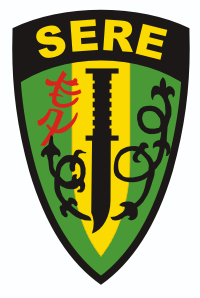SERE
« previous post | next post »
Michael Kaan writes:
I was looking up information on the SERE program after watching Zero Dark Thirty, and noticed the odd patch the program has for its insignia:
In the United States, SERE is an acronym for Survival, Evasion, Resistance and Escape. In the United Kingdom, SERE is an acronym for Survive, Evade, Resist and Extract.
Michael continues:
Of interest is the use of 虎. The article says it "alludes to the Here be dragons/tigers legend found on early maps", but on looking that up I see the standard cartography terms were either dragones or leones, and no tigers mentioned (aside from a Ray Bradbury story).
More interesting to me is the sundering of the character. I was wondering if these represent the semantophore and phonophore of hu, or if it's arbitrary. I looked up the character in Wiktionary but had no luck.
From the very beginning, hǔ 虎 ("tiger") has been a unified character. It does not consist of a semantic and a phonetic component. Originally, on the oracle bones, it depicted the form of a tiger.
There are only 8 strokes in this character (you can see them being written sequentially here), but for some reason it seems to be difficult for neophytes to write properly. The splayed out form on the patch is similar to many specimens I have seen in the homework of beginning students of Chinese and of tattoo artists who don't know Chinese.
In Mandarin, if you want to say the word for "tiger", you don't just use hǔ 虎 by itself, you have to say lǎohǔ 老虎 (lit., "old tiger"), unless you use hǔ 虎 in combination with another suitable morpheme, e.g., hǔjiàng 虎將 ("tiger-like general; brave / fierce general").

Matthew Timothy Bradley said,
January 16, 2015 @ 5:02 pm
I know nothing of Latin, but I understand that the Special Forces (i.e., Green Berets) motto De oppresso liber is a somewhat muddled, as well. https://en.wikipedia.org/wiki/De_oppresso_liber
tk said,
January 16, 2015 @ 6:11 pm
Apparently the legend, "Here be dragons … found on early maps," isn't found on any early map (tho on one early globe perhaps), see:
http://www.theatlantic.com/technology/archive/2013/12/no-old-maps-actually-say-here-be-dragons/282267/
Mark Mandel said,
January 16, 2015 @ 6:51 pm
@tk: So you're saying the legend is legendary.
I wonder if the sundered hanzi was rendered by someone who didn't read Chinese and thought it was two characters written right-to-left… and maybe misanalyzed them on top of that.
PeterL said,
January 18, 2015 @ 7:18 pm
This rendition of 虎 reminds me of the bad calligraphy in Van Gogh's Flowering Plum Tree (after Hiroshige)
(Click "left" on the image to see the original, which is better in artistry, craftsmanship, and calligraphy)
At least they didn't choose 寅, although they might have mis-drawn it better than the mis-drew 虎.